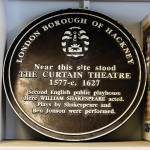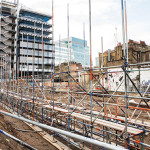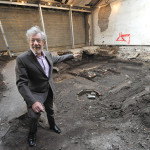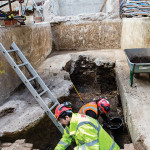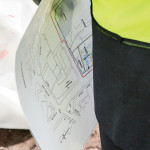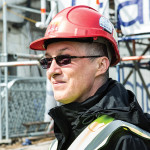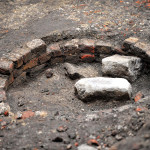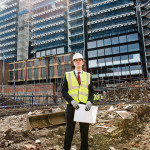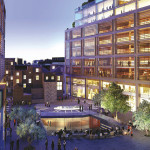Four hundred years since the death of Shakespeare, investor Cain Hoy and developer Galliard are embarking on a project to restore and redevelop the site of the Shoreditch theatre where some of the Bard’s most famous works were performed. David Hatcher reports
Uncertainty, risk and endeavour. The prospect of fame and a rich bounty. The Stage development in Shoreditch, EC2, has all the makings of a dramatic Shakespearean tale.
 The name of the £750m scheme is no accident. Nor is it a tenuous link to any old theatrical landmark. This project is on the old site of one of London’s most famous Elizabethan playhouses – the original Curtain Theatre.
The name of the £750m scheme is no accident. Nor is it a tenuous link to any old theatrical landmark. This project is on the old site of one of London’s most famous Elizabethan playhouses – the original Curtain Theatre.
Opened in 1577, the theatre famously debuted the Bard’s Henry V some 20 years later and staged performances of many other notable plays including Romeo & Juliet and Every Man in His Humour, which starred Shakespeare himself.
The ruins of the old performing space are now set to be unearthed and will, eventually, become the centrepiece of Cain Hoy and Galliard’s new development complete with 205,634 sq ft of offices and 412 flats. As well as Cain Hoy and Galliard, McCourt and Vanke have also invested into the project, which is scheduled to complete in 2019.
With such a historic excavation built into the development, this looks set to be one London project that will stand out from the current chapter of similar mixed-use schemes.
So, with such unique links to the world of performing arts − and to Shakespeare himself − how will the old and new be knitted together to create something truly unique? And do the additional costs and constraints of building around an archaeological dig site add up?
Digging down
Excavation of the original theatre begins next month and is set to last nine weeks. Historians with a keen interest in the arts will undoubtedly be clamouring to find out what is unearthed. Relatively little was written about the Curtain during its run until the 1630s and the dig is expected to reveal major clues to the way productions were staged.
“In terms of historical importance, this is pretty near the top,” says David Divers, project manager at Museum of London Archaeology, which has been employed by the developers to advise on the historical sensitivities of the site and uncover the artefacts. “You don’t get to work on many Shakespearean theatres and this will be impressive.”
MOLA has been working on the site since 2011, when it was still owned by the (coincidentally named) Bard family, and was part of the team that originally found the first remains of the theatre in 2012.
“We undertook initial desk-based research first, looking at old maps and documents and worked out there was a strong likelihood the Curtain Theatre was on site. It was pretty much a known fact really, so we did some trial excavations, digging small holes, to see what was on the site,” Divers says.
It is those early works that have given MOLA the confidence that what they will find will be significant. The maps and research documents suggest that 1.5m of the wall that stood behind the stage still survives, as does the space where the audience stood. It is also possible that other artefacts, such as discarded rubbish of the age, will reveal more about theatre-goer habits and behaviours of the time.
The hope is that whatever is uncovered will kick-start community engagement around the project.
A viewing bridge will be constructed so members of the public and interested parties can observe the dig, while an outreach programme is also being undertaken. Schools and local community members are being invited in to learn about the site and an extensive number of lectures are being put on for societies and groups studying or interested in works relating to the project.
“Archaeology generally has to be behind hoardings but more developers are starting to realise the positives for them of bringing the community onto sites. The local community are always desperate to see what is behind hoardings – they love it,” adds MOLA communications manager, Nicola Kalimeris.
This community engagement, it is hoped, will increase awareness of the site and start the early stages of placemaking. The project is to feature a 220-seat theatre, which will be associated with a visitor centre to view the archaeology that is uncovered.
“We are designing the public realm to have an amphitheatre around down towards the archaeology so the public’s eye is drawn to it. There will be just over an acre of public realm and this will be the focal point,” says Robert Allan, development director at Cain Hoy.
Practical considerations
There is no question that the potential for new discoveries beneath the ground here are exciting. But what about the challenges of developers and historians working closely together? And what are the potential hurdles of developing on an archaeological dig site?
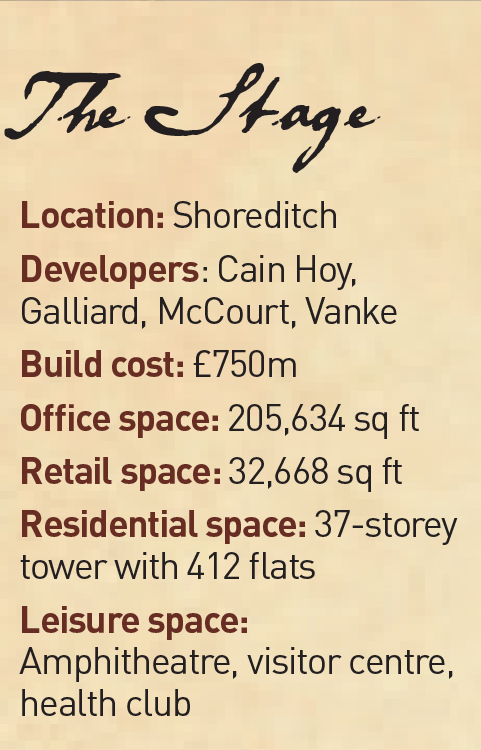 On a practical level, a temporary roof needed to be constructed ahead of the main dig to ensure that potential findings are preserved and protected from adverse weather. But more complicated are the rules and regulations. The excavation duties of the developers are established within their planning consent and they must work closely with Historic England, which acts for the council as its authority on such matters.
On a practical level, a temporary roof needed to be constructed ahead of the main dig to ensure that potential findings are preserved and protected from adverse weather. But more complicated are the rules and regulations. The excavation duties of the developers are established within their planning consent and they must work closely with Historic England, which acts for the council as its authority on such matters.
“If it were destroyed by a developer they would be in breach of planning consent and Hackney would be the party that prosecuted,” Divers says.
“That is why you must get the likes of MOLA on site and be constantly in touch with Historic England to make sure we are not doing such things. They provide architectural advice to Hackney, monitor our work and make sure we are keeping things to appropriate standards,” adds Allan.
The authority that formally oversees the responsible excavation of historical sites is the local council. In this case it is Hackney, and hypothetically the council could prosecute the developers were they not to carry out the works as prescribed within their planning consent. The maximum penalty is an unlimited fine and/or a two-year prison sentence.
Mixing old and new
The results of the excavation will become the centrepiece of the scheme, but the new buildings themselves will still be the main event. And getting them right on such a historic site will be crucial.
Determining the design of the archaeological visitors’ centre must wait until the nine weeks of excavation is complete, because what is found will shape how it can be displayed.
“It is early days on design and until we understand the levels [on which] the theatre sits exactly, that will depend how people can interact with it. Are we going to stand on top of it and view it from the top? It is an idea I really like but it might not be possible. It sits at a lower level – basement, essentially – so that may happen,” says Allan.
Perkins & Will is the architectural practice designing the scheme. It was chosen by the Bard family in part because of its expertise in dealing with archaeologically sensitive sites and when Cain Hoy and Galliard bought the site, they were retained for the same reason.
As well as the visitor centre and the new theatre, The Stage will include a 37-storey residential tower with 412 flats, 205,634 sq ft of offices and 32,668 sq ft of shops.
With the traditional core of the City spiralling out ever further, it is difficult to predict the type of occupiers it is likely to attract. The development sits next door to Brookfield’s 600,000 sq ft Principal Place, E1, which is let to Amazon, and the eclectic mix of restaurants and bars in the surrounding Shoreditch area are obvious attractions for media and tech companies.
The largest office building – the 120,000 sq ft The Bard – is envisaged as a headquarters, while the 70,000 sq ft The Hewett building is more likely to be split up in a style more suitable for start-ups and smaller businesses.
The retail buildings, which will also have some small offices on the upper floors, are likely to in part emulate the nearby Boxpark, which is made up of shipping containers that are easy and cheap to fit out and are attractive to small retailers.
Having a reasonable amount of clarity over the areas of historical significance on the site has given the developers a high degree of confidence that they can build it out without dramatic disruption. But the archaeological process inevitably comes with dramatically increased costs and slower progress.
The cost is “a significant figure”, so much so that the developers were not required to provide affordable housing, although have voluntarily opted to develop 40 flats offsite.
“The cost is not modest and there are a lot of knock-on effects. You have an area you would have naturally used and now cannot be used for practical things that help a mixed-use development run,” Allan says.
But Cain Hoy and Galliard hope that the exhibition centre and the theatre will add far more to The Stage’s overall value than it has cost them.
“We will be able to commercialise the theatre and at the same time preserve it for future generations,” adds Allan. “It creates a cultural hub and means it is not just another office and residential development.
“We knew early on about what was here, we have plugged it in to the programme and it is a blessing. It will be on all of the tour guides and give the area a real boost.”
Working up a scheme on a site of such historic importance is far from straightforward. But if the developers’ vision comes to life, The Stage’s future looks set to be a world away from the ending of a Shakespeare tragedy.
• To send feedback, e-mail david.hatcher@estatesgazette.com or tweet @hatcherdavid or @estatesgazette








